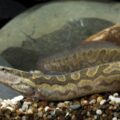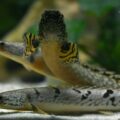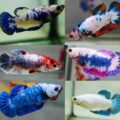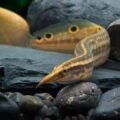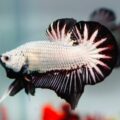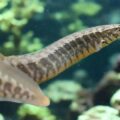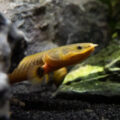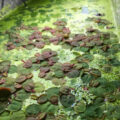This comprehensive guide provides details on keeping the Asian Swamp Eel, a predatory eel species, as a pet. You will learn how to identify this species, aquarium setup, water parameters, feeding, and much more about its complex, specialized care!
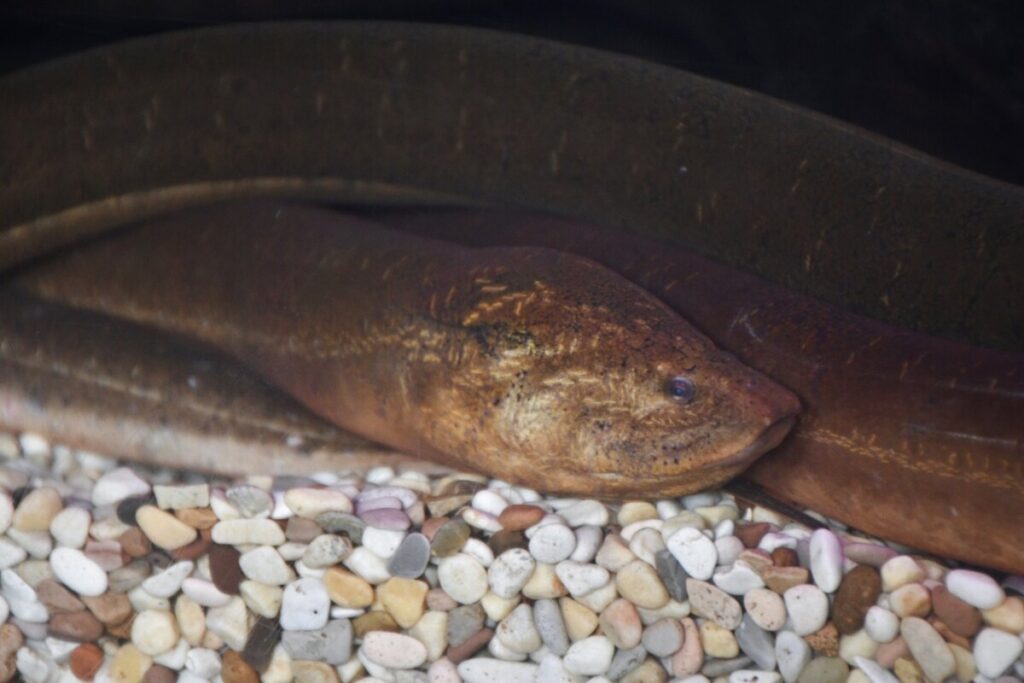
Asian Swamp Eel: Powerful, Burrowing Predator
Monopterus albus, or Asian swamp eels, sometimes called the Rice eels or white rice-field eels because of their natural habitat, are air-breathing freshwater predators.
Despite being a common food source in Asia, aquarium enthusiasts interested in large freshwater eel care can add this species to their home aquariums.
In this Monopterus albus intro, you’ll learn that Asian swamp eels are hermaphrodite escape artists with powerful bites that works for their predatory nature and a defense mechanism plus much more.
Keep reading this Asian swamp eel overview for tips on keeping and breeding this species.
Author’s Note: Check out our post on The 13 Freshwater Aquarium Eels That Can be Kept as Pets for even more eels!
Natural Habitat & Survival Skills

The Asian swamp eel habitat inspires its many names, from Rice Paddy eel to White-rice field eel and ricefield eel.
They’re native to Eastern and Southeastern Asia rice fields, which are often swampy, making them a drought-resistant freshwater species.
This Asian swamp eel environment also encouraged their survival instincts, like burrowing to avoid drought and breathing air to tolerate low-oxygen waters.
Understanding the Monopterus albus’ natural range helps you prepare adequately for keeping it in an aquarium, but first, let’s help you identify an Asian swamp eel.
Identifying Features & Size

Monopterus albus features are unique, which makes identification easy, but beginners can make rookie mistakes. To identify Asian swamp eel species, pay attention to these physical and characteristic traits.
The rice eel has a long, scaleless body with no pectoral fins and typically grows between 2-3ft, but can only extend to a maximum of 1m (100cm).
Although it has a small head and tiny teeth, the Asian Spiny eel’s bite is sharp and painful. The Asian swamp eel’s appearance is often confused with smaller spiny eel species, but with these tips, you can correctly distinguish them. Now, let’s build a home for your new pets.
Aquarium Setup & Escape-Proofing

A few things to note when designing an Asian swamp eel tank setup include their physical appearance, habits, and natural environment.
Build for Size
The best tank for large eels like Asian swamp species is long and deep to hold at least 100 gallons of water. Because this species is snake-like, the long tank allows comfortable movement for this pet.
Build for Habit
Asian swamp eels are always looking for a way out, so use these escape-proof aquarium tips to keep them safe and secure.
- Cover the tank with a secure yet aerated lid.
- Seal all gaps with aquarium-safe silicone.
- Add a clip to your lid or place a heavy item on it for reinforcement.
Build for Comfort

Because Asian swamp eels are escape artists that need surface air access, there are a few more things to add to your tank to ensure they feel comfortable.
Preferably, use fine sand for a deep substrate tank setup that allows burrowing without harming your pet’s body. Also, pick decor pieces with round, smooth, soft surfaces that are gentle on the skin.
Your setup doesn’t end with decor and tank choices. You must also create an environment that mimics your Asian swamp eel’s natural water parameters.
Water Parameters & Filtration

Penn-Plax Cascade All-in-One Aquarium Canister Filter
Found On Amazon
Setting proper Asian swamp eel water conditions and keeping it stable and clean are key care practices for ensuring your pet’s health.
Water Parameters
The ideal water parameters for this species are as follows:
| Temperature | 75–82°F |
| pH | 6.5–7.5 |
| Hardness | 3 – 25 dGH |
Filtration
Because this species is a messy eater that releases a high bioload, you’d need a robust filter to keep the water clean.
Ensure strong filtration for large predatory fish like Asian swamp eels. You can use an external double-canister system set to a strong current to keep the nitrogen cycle going, especially after feeding.
Next on this Monopterus care guide is dieting and feeding management.
Feeding Habits & Diet

In the wild, Asian swamp eels prey on smaller and weaker species, so, as pets, you must provide a regular carnivorous aquarium fish diet.
Use this Asian swamp eel feeding guide to ensure your pets have the nutrients from their controlled diet.
Asian swamp eels will hardly accept pellets even if they’re made for carnivores because of their nature. So, feed them live foods to encourage their predatory instinct and engage their strong jaws.
Here’s a specific table showing what to feed Monopterus albus:
| Food Type | Options |
| Live Food | Smaller fish, Earthworms, Shrimps |
| Supplements | Carnivorous Pellets |
After figuring out an appropriate Asian swamp eel diet, your next move is scheduling feeding time.
This species is a nocturnal feeder, so set your feeding time towards night for the best reception and avoid pairing tank mates that can become prey.
Tank Mates & Behavior

Because of their predatory nature, Asian swamp eels are typically a solitary aquarium fish species.
You can keep multiple Asian swamp eels in one tank easily, but as a community tank member, it’s a bad idea. Asian swamp eel compatibility stops with other Monopterus albus. Ignoring this advice means you risk your pets attacking other tankmates.
Managing Asian Swamp Eels’ Behavior
By now, you have an idea of the Monopterus albus temperament and why it’s a solitary pet. But here’s more insight on how to manage its habits and provide specific predator fish care.
When your Asian swamp eel feels threatened or sees prey, it becomes aggressive, so don’t be surprised by its reaction during feeding times.
As a solitary pet, this species burrows under the substrate during the day and comes out at night.
Health & Common Issues
Despite being a hardy species, Asian swamp eel health care still requires specific precautions.
All the swamp eel care tips in this guide, from providing a suitable habitat to dietary restrictions and avoiding tank mates, are ways to reduce the risk of illness.
Poor water management and improper tank setup lead to common diseases like bacterial and fungal infections, rotting from untreated injuries, and stress.
Key take away from this section is to maintain proper and stable water parameters, without this the tank’s water quality can degrade, which can cause a wide range of issues from cloudy aquarium water to illness and mass die off.
So, ensure you inspect your pets periodically to detect any wounds from rocks and tank decor, and administer treatment immediately.
Lifespan & Keeper Commitment

Following the rules in this Monopterus albus guide strictly means your pets can live up to 15 years in good health. So, keeping Asian swamp eels is a long-term commitment best reserved for experienced hobbyists.
Because of the Asian swamp eel’s lifespan and unique care needs over time, you’d need a large space, preferably a pond, to house them and a strict maintenance schedule for their upkeep.
Once you have access to an ideal setup with enough live food and periodic health checks, you’re ready for long-term eel care.
Conclusion: Is the Asian Swamp Eel Right for You?
As we close this guide, let’s recap the essentials for keeping Asian swamp eel species in your tank.
- They’re big fish that need large spaces to live.
- They’re predatory and prefer live food.
- They’re escape artists, always looking to leave the tank.
With this large eel care summary, you can adequately prepare and succeed at keeping one or more Asian swamp eels.
When you consider exotic aquarium fish, such as their food preferences and temperaments in community tanks, you’d understand why they’re solitary pets.
The final Monopterus albus advice you’d get is to leave the care of this complex species to specialized aquarists. They have the expertise to make it a rewarding experience.
Let us know if you’re up to the task in the comment section below.


